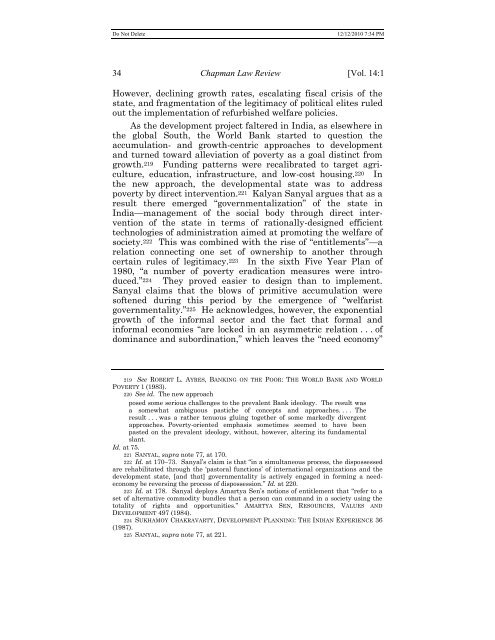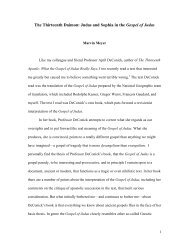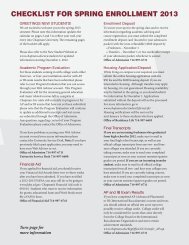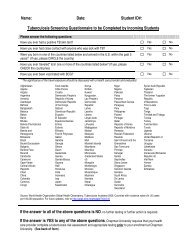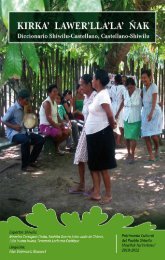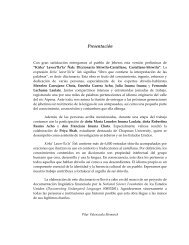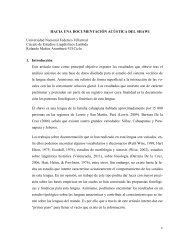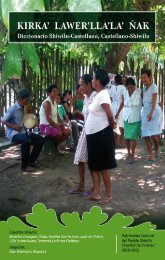“Surplus Humanity” and the Margins of Legality - Chapman University
“Surplus Humanity” and the Margins of Legality - Chapman University
“Surplus Humanity” and the Margins of Legality - Chapman University
Create successful ePaper yourself
Turn your PDF publications into a flip-book with our unique Google optimized e-Paper software.
Do Not Delete 12/12/2010 7:34 PM<br />
34 <strong>Chapman</strong> Law Review [Vol. 14:1<br />
However, declining growth rates, escalating fiscal crisis <strong>of</strong> <strong>the</strong><br />
state, <strong>and</strong> fragmentation <strong>of</strong> <strong>the</strong> legitimacy <strong>of</strong> political elites ruled<br />
out <strong>the</strong> implementation <strong>of</strong> refurbished welfare policies.<br />
As <strong>the</strong> development project faltered in India, as elsewhere in<br />
<strong>the</strong> global South, <strong>the</strong> World Bank started to question <strong>the</strong><br />
accumulation- <strong>and</strong> growth-centric approaches to development<br />
<strong>and</strong> turned toward alleviation <strong>of</strong> poverty as a goal distinct from<br />
growth. 219 Funding patterns were recalibrated to target agriculture,<br />
education, infrastructure, <strong>and</strong> low-cost housing. 220 In<br />
<strong>the</strong> new approach, <strong>the</strong> developmental state was to address<br />
poverty by direct intervention. 221 Kalyan Sanyal argues that as a<br />
result <strong>the</strong>re emerged ―governmentalization‖ <strong>of</strong> <strong>the</strong> state in<br />
India—management <strong>of</strong> <strong>the</strong> social body through direct intervention<br />
<strong>of</strong> <strong>the</strong> state in terms <strong>of</strong> rationally-designed efficient<br />
technologies <strong>of</strong> administration aimed at promoting <strong>the</strong> welfare <strong>of</strong><br />
society. 222 This was combined with <strong>the</strong> rise <strong>of</strong> ―entitlements‖—a<br />
relation connecting one set <strong>of</strong> ownership to ano<strong>the</strong>r through<br />
certain rules <strong>of</strong> legitimacy. 223 In <strong>the</strong> sixth Five Year Plan <strong>of</strong><br />
1980, ―a number <strong>of</strong> poverty eradication measures were introduced.‖<br />
224 They proved easier to design than to implement.<br />
Sanyal claims that <strong>the</strong> blows <strong>of</strong> primitive accumulation were<br />
s<strong>of</strong>tened during this period by <strong>the</strong> emergence <strong>of</strong> ―welfarist<br />
governmentality.‖ 225 He acknowledges, however, <strong>the</strong> exponential<br />
growth <strong>of</strong> <strong>the</strong> informal sector <strong>and</strong> <strong>the</strong> fact that formal <strong>and</strong><br />
informal economies ―are locked in an asymmetric relation . . . <strong>of</strong><br />
dominance <strong>and</strong> subordination,‖ which leaves <strong>the</strong> ―need economy‖<br />
219 See ROBERT L. AYRES, BANKING ON THE POOR: THE WORLD BANK AND WORLD<br />
POVERTY 1 (1983).<br />
220 See id. The new approach<br />
posed some serious challenges to <strong>the</strong> prevalent Bank ideology. The result was<br />
a somewhat ambiguous pastiche <strong>of</strong> concepts <strong>and</strong> approaches. . . . The<br />
result . . . was a ra<strong>the</strong>r tenuous gluing toge<strong>the</strong>r <strong>of</strong> some markedly divergent<br />
approaches. Poverty-oriented emphasis sometimes seemed to have been<br />
pasted on <strong>the</strong> prevalent ideology, without, however, altering its fundamental<br />
slant.<br />
Id. at 75.<br />
221 SANYAL, supra note 77, at 170.<br />
222 Id. at 170–73. Sanyal‘s claim is that ―in a simultaneous process, <strong>the</strong> dispossessed<br />
are rehabilitated through <strong>the</strong> ‗pastoral functions‘ <strong>of</strong> international organizations <strong>and</strong> <strong>the</strong><br />
development state, [<strong>and</strong> that] governmentality is actively engaged in forming a needeconomy<br />
be reversing <strong>the</strong> process <strong>of</strong> dispossession.‖ Id. at 220.<br />
223 Id. at 178. Sanyal deploys Amartya Sen‘s notions <strong>of</strong> entitlement that ―refer to a<br />
set <strong>of</strong> alternative commodity bundles that a person can comm<strong>and</strong> in a society using <strong>the</strong><br />
totality <strong>of</strong> rights <strong>and</strong> opportunities.‖ AMARTYA SEN, RESOURCES, VALUES AND<br />
DEVELOPMENT 497 (1984).<br />
224 SUKHAMOY CHAKRAVARTY, DEVELOPMENT PLANNING: THE INDIAN EXPERIENCE 36<br />
(1987).<br />
225 SANYAL, supra note 77, at 221.


